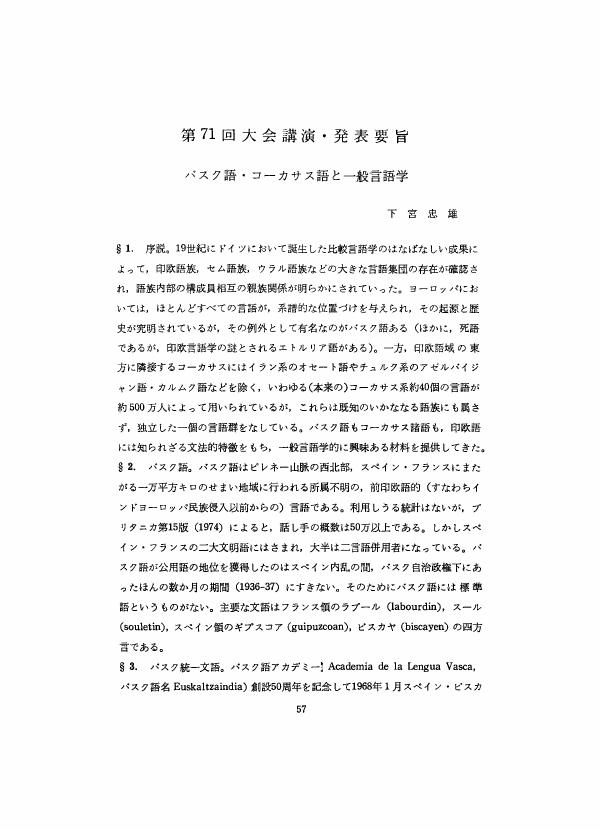4 0 0 0 アグネーテと人魚、ジプシー語案内ほか
2 0 0 0 IR デンマーク語とドイツ語の対照研究
- 著者
- 下宮 忠雄
- 出版者
- 学習院大学
- 雑誌
- 人文 (ISSN:18817920)
- 巻号頁・発行日
- vol.2, pp.67-94, 2003-03-25
この小論はデンマーク語とドイツ語の対照文法の試みである。英語とドイツ語の対照文法はめずらしくないが、デンマーク語とドイツ語は、私の知る限り、まだない。デンマーク語(言語人口500万)とドイツ語(言語人口1億)はどちらもゲルマン語族の言語だが、系統的にはデンマーク語は北ゲルマン語(=ノルド語)に属し、ドイツ語は英語・オランダ語と同様、西ゲルマン語に属する。距離の近い言語の比較は、共通点が多いから、つまらないとも言えるが、それだけに、むずかしいとも言える。主要な相違点を4点あげる。(1)音韻的相違:ドイッ語は第2次子音推移(second consonant shift)を経たが、デンマーク語にはそれがない(デdag"day"、ドTag)。デンマーク語は、他のノルド語(スウェーデン語・ノルウェー語など)と同様、子音の同化(assimilation)が強力に起こる(デdrekke"drink",ドtrinkenにおいて、前者drekkeはdrenkeのnkがkkになっている)。(2)形態論:ドイツ語では述語的形容詞は語尾変化しない(das Haus ist groB"the house is large", die Hauser sind groB"the houses are large")が、デンマーク語は、他のノルド語と同様、性・数の変化をする(上記の例はhuset er stor-t, husene er stor-e)。ドイツ語はwer(誰が)、 wem(誰に)、 wen(誰を)の格変化を保持しているのに対し、デンマーク語は、スウェーデン語やノルウェー語と同様、hvem(誰が、誰に、誰を)に融合してしまった(格の融合case-syncretism)。その際、与格(dative)が生き残った(英語whom, him, themの一mと同じ)。また、ドイッ語はmir(私に)、 mich(私を)、 dir(君に)、 dich(君を)のように与格と対格を区別して残っているが、デンゼーク語はmig(私に、私を)、 dig(君に、君を)のように、同形になってしまった。その際、対格が生き残った(-gはゴート語mik, Pikのkにあたる)。(3)総辞論:デンマーク語では、英語と同様、対格の関係代名詞が省略されている(ドイツ語、オランダ語、フランス語などでは、このようなことは起こらない)。studenten, jeg kender"the student Iknow", huset, han bor i''the house he lives in"など。(4)語彙:典型的なノルド語の単語にgammel"01d", hest"horse", ild"丘re",φ1''beer", gφre"do"などがあり、ドイツ語はalt, Pferd,Feuer,・ Bier, tunで、まったく異なっている。 The paper deals with Danish and German in a contrastive framework. When we compare two languages, it may be easier, in some respects, for linguistically distant languages like Japanese and Enghsh, and more dif丘cult for closely related languages like English and German. What about Danish and German, both of the Germanic family~Historically, English and German are nearer than Danish and German, since English and German are in the West Germanic group, while Danish is in the North Germanic(Nordic)group. Materials are largely taken from Hans Christian Andersen's Eventyr(Fairy T吾les)and their German translation. Among the differences between Danish and German may be mentioned(1)phonologically, stronger assimilation in Danish(drikke"drink"from*drinke, German trinken, lille"little"from *litle, both in regressive direction),(2)grammatically, agreement in gender and number in predicative a(ljectives (huset er stort ''the house is large", husene er store ''the houses are large"), where the a(ljectives in German are not declined, nominative-dative-accusative syncretism in favor of the dative(hvem"who, whom"),where German has wer-wem-wen, and of the accusative(mig"me", dig"thee")for German mir-mich, dir-dich,(3)syntactically, omission of the accusative relative pronoun(studenten, jeg kender"the student I know"), where German has der Student, den ich kenne,(4)lexically, typically Nordic words(gammel"old", hest"horse", ild"fire",φ1"beer", g¢re"do")for German alt, Pferd, Feuer, Bier, tun.
2 0 0 0 ジョルジア語の構造
- 著者
- 下宮 忠雄
- 出版者
- 弘前大学
- 雑誌
- 文経論叢. 文学篇 (ISSN:03854191)
- 巻号頁・発行日
- vol.4, pp.29-52, 1968
1 0 0 0 OA 第71回大会講演・発表要旨
1 0 0 0 IR ヨーロッパ諸語の類型論
1 0 0 0 OA ヨーロッパ諸語の類型論
- 著者
- 下宮 忠雄
- 出版者
- 専修大学学会
- 雑誌
- 専修人文論集 (ISSN:03864367)
- 巻号頁・発行日
- vol.87, pp.335-348, 2010-10-20
博士論文要旨および審査報告:学位授与年月日;平成22年3月30日,学位の種類;博士(文学),学位記番号;[博]文乙第8号
1 0 0 0 OA バスク語・コーカサス語と一般言語学
- 著者
- 下宮 忠雄 Tadao Shimomiya
- 出版者
- 學習院大學文學部
- 雑誌
- 研究年報 = The annual collection of essays and studies, Faculty of Letters (ISSN:04331117)
- 巻号頁・発行日
- no.23, pp.131-159, 1977-03-20
1 0 0 0 IR 渋谷の「オスロ」と6人の先生と10冊の本
- 著者
- 下宮 忠雄
- 出版者
- 学習院大学
- 雑誌
- 学習院大学ドイツ文学会研究論集 (ISSN:18817351)
- 巻号頁・発行日
- vol.9, pp.23-41, 2005
1 0 0 0 IR ジプシー語研究のために
- 著者
- 下宮 忠雄
- 出版者
- 学習院大学
- 雑誌
- 人文 (ISSN:18817920)
- 巻号頁・発行日
- vol.3, pp.159-178, 2004
「ジプシー語研究のために」はEA. Pott, E Miklosich, N. Boretzkyなどに基づいてジプシー語の特徴を述べたものである。ジプシー語を最近はロマニー語ということが多い。近年、International conference on Romani linguisticsのような国際的な学会も誕生している。ロム(Rom)はジプシーの自称で、「人間」の意味である。彼らは紀元1000年ごろ、インド西北部から移動を始め、ヨーロッパ各地に入り込んだ。その言語は本質的にインド語であるが、放浪の途上で、いろいろな言語から単語や表現を借用した。「考える」(denkawa)のような基本的な単語もドイッ語から借用した。 私自身は、バスク語、コーカサス語などと並んで、ジプシー関係の辞書・参考書を30年ほど前から収集してきた。Miklosich(ミークロシチ)の現物をオランダのJan de Rooyから入手したときは小躍りしたものだ。英文科図書室には長い間お世話になったが、GeorgeBorrow全集は本当にありがたかった。本論はオリジナルな研究とはいえないが、一つの特徴づけ(characterization)のつもりである。This paper gives a synopsis of the Gypsy language based largely on the works by FA.Pott, F.Miklosich and N.Boretzky. The language, caUed Romany in linguistics(from rom, the self-designation of the Gypsy),is north-westcrn Indian量n origin, but has adopted a large number of words丘om Greek, Armenian, Rumanian, Serbo-Croatian and Russian. The word pal(pen pal)comes from Gypsy phral"brother"(Sanskrit bhrata"brothcr").The number of speakers is estimated at seven to eight minion, half of them in Europe, ofwhom two-thirds live in East European countries. Alnong grammatical characteristics is the disappearance of the infinitive and its syntactic device as in Balkan languagcs. A sample of texts is given togethcr with notcs, translation and a glossary.
1 0 0 0 ソシュール自筆原稿の研究
この研究の出発点は、言語学習ソシュールの残した自筆原稿や学生の講義ノートで研究者自身がマイクロフィルム撮影し、そこから研究することであった。この段階で我々が実証したことは、マイクロフィルムは専門の技術者にその作製をまかせるより、研究者が自分で影写した方がはるかに安価で上質のものができるということであった。次の段階でこれを全国の研究者に公開した。そのためにマイクロフィルムを長巻のままとせず、帰国して紙に定着させ、整理した上で、分類目録を発行して検索しやすくした。その結果、この資料集から多くの論文や著書が生れた。この研究に対して、日本国内から幾つかの反応があった。その一つは日本人が外国の文化に対してこういうことをやるのは、研究者として謙虚さに欠けるという批判、また、純粋に、資料を提供するという目的でやればいいのに、君の書いた英語版の序文は討論家気取りである等。自分自身の著わした著書は外国でも幾つかの書許の対象になったが、日本国内では、大学院の教科書にも使われるようになった(例、名古屋大学、大学院)同書の英訳版は補遺を伴って全三巻として英国のパ-ガモン書店より発行された(二巻まで既刊)。欧文研究誌FENESTRAはこれらの研究の成果を海外に発信するために企画された。ソシュールの『一般言語学講義』は言語学の「原論」であり、また他の多くの分野の人々に刺激を与えている。この研究誌の発行を通じて、多くの全国の研究者とネットワークを作った。
1 0 0 0 OA 受動文はヨーロッパ諸語において好まれるか
- 著者
- 下宮 忠雄
- 出版者
- 日本言語学会
- 雑誌
- 言語研究 (ISSN:00243914)
- 巻号頁・発行日
- vol.1987, no.91, pp.118-119, 1987-03-25 (Released:2010-11-26)
- 著者
- 下宮 忠雄
- 出版者
- 学習院大学
- 雑誌
- 学習院大学言語共同研究所紀要 (ISSN:02899736)
- 巻号頁・発行日
- vol.1, pp.6-7, 12, 32, 1978


